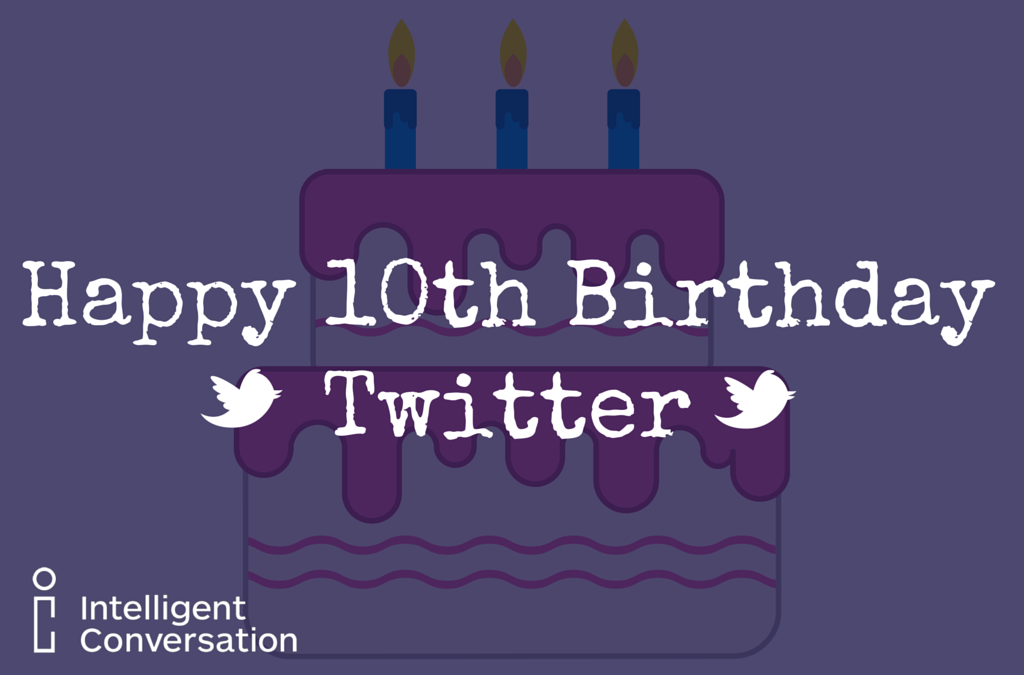Today Twitter turns 10 and can mark the occasion boasting an impressive 320 million active monthly users, but I can still remember a point when I thought Twitter was ‘for the kids’. It was about six years ago that I gave in and joined; since then I’ve seen it grow from a niche social platform, to the second largest social network.
The micro-blogging site has had a tough 12 months; calls for more action to be taken against trolls, a tail off in new users, a spate of high-level resignations and the #RIPTwitter reaction to a re-ordered, non-chronological timeline.
So what has defined the social platform over the past 10 years? Here are 10 things you need to know:
- Originally invented as a texting service, Twitter was created in 2006 by students Jack Dorsey, Noah Glass, Biz Stone and Evan Williams as a way to send text messages to a large group of people. Initially called Twttr, they bought the domain Twitter.com from a birdwatching website (hence the little blue bird logo).
- The first ever tweet was sent on 21 March 2006 by Jack Dorsey and read, ‘Just setting up my Twttr.’
- In 2011, as political unrest in the Middle East continued to build and as regional news agencies were censored, Twitter became a prime tool for organising demonstrations and giving the world a front line view – people used the hashtag #ArabSpring and events in Egypt, Syria, Tunisia and Yemen were reported under this banner. In the UK Twitter was accused of fuelling the London riots by the authorities, as users posted pictures of themselves and their looted goods.
- In April 2011, the then shadow chancellor Ed Balls tweeted, ‘Ed Balls.’ It was subsequently retweeted 25,000 times and liked 10,000 times. Ed Balls Day is now celebrated on 28 April every year to commemorate the date of the accidental tweet.
- Ellen Degeneres’ Oscar selfie is the most retweeted tweet ever, followed by a 1D tweet, with President Obama’s ‘Four more years,’ tweet coming in at third place.
- The Twitter account that reached 1 million followers the fastest was Caitlyn Jenner’s.
- With falling engagement and a trail off in new users, Twitter has made some changes to its offering in the past year, including GIF attachment, Moments and a change to the timeline algorithm, so tweets and accounts you engage with most will be shown at the top of your timeline. However Twitter users have been sceptical of the changes, with the #RIPTwitter hashtag trending only hours after the news was announced.
- Katy Perry is the most followed account on Twitter with 84.2m followers, followed by Justin Bieber at 77m. President Obama is the most followed world leader, with 71m followers (David Cameron has 1.39m followers).
- There are 320m monthly active Twitter users and 80% of Twitter use is through mobile. 22% of internet users are active Twitter users (the total number of internet users who use Twitter is 39%).
- Twitter’s world revenue in 2015 was $2.2bn. Advertising revenue for the platform for 2017 is expected to reach $3.26bn. Twitter lost $521m in 2015.
Twitter has come a long way in 10 years, but as advertising profit becomes important to the platform, it needs to attract more active users to demonstrate ROI for the brands who advertise with it. This will inevitably means changes to the social network, which users may not like. A common accusation is that Twitter is becoming too much like Facebook (GIFs in posts, videos, tagging in pictures and the rumour of the scrapping of the 140 character limit).
Twitter needs to adapt to survive and users need to understand that change is inevitable. Whilst I’m pretty happy about being able to tag people in images and upload GIFs, I’m worried about the scrapping of the 140 character limit. Twitter needs to make changes, so borrowing good ideas from other platforms is great, but it should also celebrate what makes it different (because that’s why we love it).
Will Twitter survive the next 10 years? And what changes will this mean for the platform? We can’t wait to see.
Happy Birthday Twitter.
Further reading:
- David Higgerson gives advice on how newspapers can better use Twitter (but really it’s good advice for every business): https://davidhiggerson.wordpress.com/2016/03/20/twitter-at-10-11-things-newsbrands-can-do-to-get-better-at-twitter/
- Mashable’s analysis of Twitter’s recent changes and whether this could signal a collapse for the brand: http://mashable.com/2016/03/20/how-twitter-could-fade-away/#5hqy3PgyCEq5
